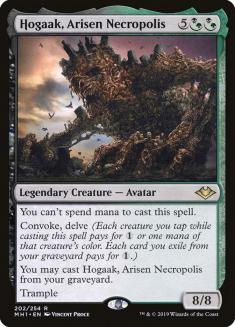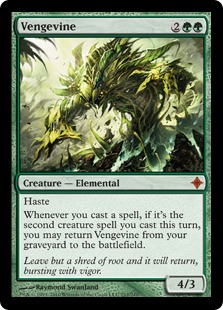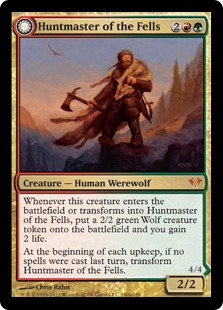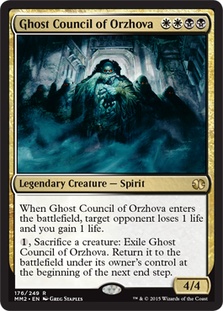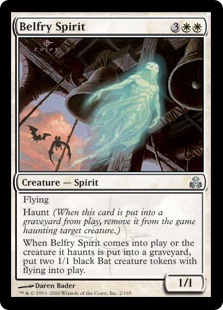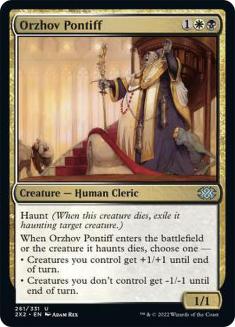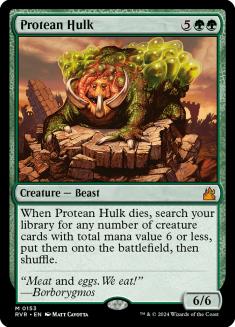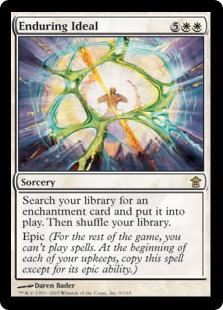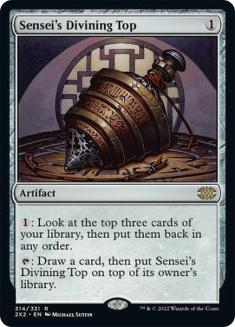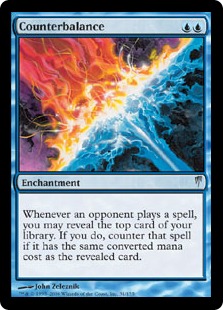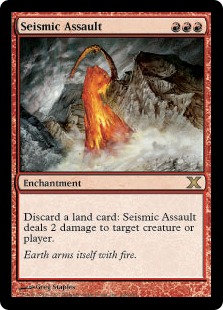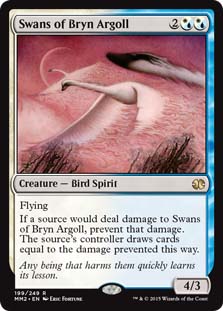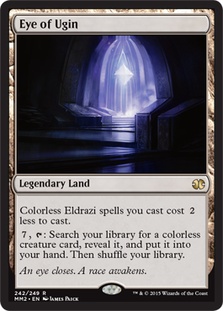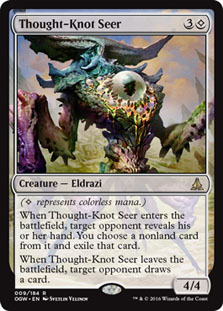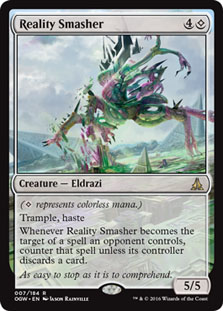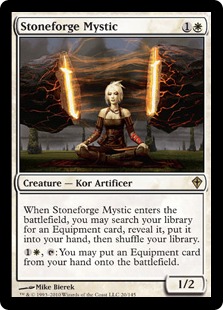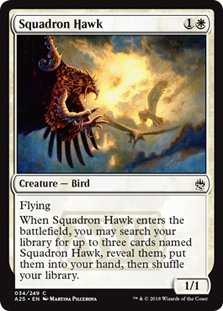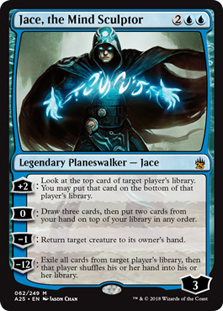Late last year, I wrote an article about the five worst decks I had ever played in a tournament and lessons to be drawn from them. Today, I’m going to write about the best eight decks I’ve ever played and lessons to be drawn from them.
Let’s begin!
8. Hogaak at Mythic Championship IV (2019)
Creatures (31)
- 4 Carrion Feeder
- 4 Bloodghast
- 4 Hedron Crab
- 4 Vengevine
- 4 Gravecrawler
- 3 Satyr Wayfinder
- 4 Stitcher's Supplier
- 4 Hogaak, Arisen Necropolis
Lands (20)
Spells (9)

Mythic Championship IV was another one of those stories where there’s an established best deck, people try to beat it for two weeks, and they ultimately fail. Most of the time, we’re the people trying to beat it until the last day, but this time around we actually recognized that the deck was just broken and we focused on it much earlier in the process, to some pretty good results.
Hogaak was not a surprise; everyone knew it was going to be the most popular deck and people were ready. Sometimes, the best deck is something that you can’t really hate — such as Temur Reclamation, Sultai Control (Yorion), Jeskai Blink (Yorion) — where there isn’t a card that will singlehandedly win the game but there are several tools to hate on graveyard decks, and there are several cards that can win the game on their own. At Mythic Championship IV, people played all these cards. And, still, Hogaak was the best deck by far. It was just too fast, too reliable, too resilient, and too powerful.
If you only looked at the Top 8 of the tournament, it might not have seemed like Hogaak dominated. After all, there was only one copy, and the tournament was won by Mono-Green Tron. However, looking at the win rates for Modern specifically tells a different story. In the list of 8-2 and 9-1 Modern decks, there were eleven Hogaak builds out of twenty decks, and Hogaak had the highest win rate of any deck with more than two players playing it. This is with everyone trying their hardest to beat it at all points!
The deck warped the format around it and still came out on top, and it was rightfully banned afterwards. I myself had an 8-2 record with it, and felt I had to get pretty unlucky with my two losses, even though everyone was trying their hardest to beat me.
7. Wolf Run Ramp at Pro Tour Dark Ascension (2012)
Creatures (16)
- 3 Solemn Simulacrum
- 1 Birds of Paradise
- 1 Acidic Slime
- 2 Inferno Titan
- 4 Primeval Titan
- 1 Thrun, the Last Troll
- 4 Huntmaster of the Fells
Lands (25)
Spells (19)

My journey to playing Wolf Run Ramp in Honolulu was a bit weird. During basically all of testing, I believed I was going to play Azorius Delver, the deck I had Top 8’ed GP Orlando a few weeks before. We had a good list, we had good sideboard plans, everything — so much so that, the day before deck submission, I actually left to sightsee! I’m normally a pile of nerves before deck submission, and I spend hours and hours agonizing over the last couple of slots, but I was so confident in my deck that I felt I could spare time to relax.
By the time I came back, everyone on the team decided they were going to play this Gruul deck, an entirely new brew that we had not actually tested before. I’m not sure where this deck even came from, but in the span of half a day about ten people had converted to it, and I was left having to decide if I was going to play my trusty Azorius deck or this new thing, knowing I would not have the time to figure out for myself if it truly was good.
In the end, I opted to play the Gruul deck the rest of the team had settled on in my absence. The key breakthrough here was Huntmaster of the Fells, a card that worked on offense or defense, that bridged the gap between your acceleration and your bigger threats, and that allowed you to win the midgame as well, rather than focusing just on the late-game.
Normally, ramp decks are all about setting up a big play. If that big play is dealt with, they’re left with a bunch of mana sources; this makes them vulnerable to counterspells, discard, and even bounce and removal some of the time. By adding Huntmaster of the Fells, the deck could start applying pressure as early as Turn 3, and the Werewolf mechanic made it hard for the Delver decks to leave mana up to react to your Titans.
I ended up getting second place at the PT, losing to Brian Kibler with the exact same deck in the finals. Kibler himself was originally going to play a Gruul Aggro deck, but switched to the ramp list because he thought he would never beat ramp with Gruul Aggro and he assumed he’d have to go through some of us to win the tournament. Turns out he was right!
6. Orzhov Tokens at Pro Tour Charleston (2006)
Creatures (25)
- 4 Dark Confidant
- 3 Belfry Spirit
- 4 Ghost Council of Orzhova
- 4 Orzhov Pontiff
- 4 Plagued Rusalka
- 3 Skeletal Vampire
- 3 Teysa, Orzhov Scion
Lands (22)
Spells (13)
Sideboard

Pro Tour Charleston was a special event for me — it was my very first PT Top 8 — and it was also a unique format, Team Block Constructed. Normally, in Standard, we’re working with six to nine sets; in Block Constructed, we were working with only three. This already narrowed the pool of playable cards, and then the fact that it was teams, meaning you could only play four copies of a card among the three decks, made it so that people had to dig deep to find good strategies.
To make things even harder, it was Ravnica Block Constructed, and Ravnica was a gold set, so you couldn’t just play a bunch of monocolored decks with no overlap and call it a day; you had to try to find a way to play as many gold cards as possible between the three decks because this was where the power of the format lay.
This was why this deck was so good. Not only was the deck itself extremely powerful (I had a very good record and so did everyone else who played similar versions), it was also powerful without taking away things from other decks, because its power came mostly from synergy. I was playing cards like Ghost Council of Orzhova, Orzhov Pontiff, Belfry Spirit, Plagued Rusalka, and Castigate, which other people didn’t want, and playing them to good effect.
Normally, I’m a big fan of playing the good cards; you won’t catch me dead with stuff like Ornithopter if I can help it. However, in this case, due to the team nature of it and the limited card pool, a deck that could succeed while playing bad cards was a godsend because it allowed us to concentrate the good cards (and multicolored lands!) in our other two decks (Naya Aggro and Sultai Control). Having this deck in our lineup was a big edge, and the main reason we got second place at that tournament.
5. Flash Hulk at Grand Prix Columbus (2007)
Creatures (9)
- 1 Kiki-Jiki, Mirror Breaker
- 1 Carrion Feeder
- 1 Karmic Guide
- 1 Body Snatcher
- 1 Benevolent Bodyguard
- 4 Protean Hulk
Lands (18)
Spells (33)

Flash Hulk was perhaps the most intrinsically powerful deck I’ve ever played. It was a Turn 2 combo deck that could win at instant speed and packed an incredible amount of disruption and card selection. Between Force of Will, Daze, Duress, and Unmask, on top of a bunch of tutors and card drawing, it was very consistent at winning on Turn 2 and very hard to stop. The only reason it’s not further up on the list is because a lot of people were playing this deck at the tournament, and it didn’t really feel like I had that big an edge when half the matches were mirrors (but the matches versus everyone else felt easy).
For those who don’t know, this is the combo:
You pay two mana and cast Flash, and then you put Protean Hulk onto the battlefield. Sacrifice the Hulk, and the leave-the-battlefield effect triggers; once that happens, you can chain this effect multiple times and end up with a guaranteed kill that will win through removal (though if it’s Swords to Plowshares, they can exile the Protean Hulk itself).
Flash Hulk wasn’t a novelty by the time the GP came around. Everyone knew about it, and most people were trying to beat it, myself included. I remember trying very hard to beat it during testing and failing so miserably that it became impossible to justify playing anything else. Much like with Hogaak, the environment we faced at the tournament was very hostile, yet the deck still performed the best, and the deck still won the tournament (though not my list).
As far as lists go, I think my individual choices were very good, though the differences were mostly small details. My bullets were better than other people’s (Rushing River main, Goblin Chirurgeon, Massacre, Reverent Silence, and Energy Field in the sideboard); my tutors were black and blue so I could pitch them to both Unmask and Force of Will; I had four copies of Lim-Dul’s Vault; and so on. The list that won took a more controlling approach (it had Sensei’s Divining Top and Counterbalance), which was possibly better, but I still liked mine a lot and I felt I was hugely favored versus literally everyone who wasn’t also playing Flash.
4. Enduring Ideal❄ at Brazilian Nationals (2006)
Creatures (4)
Lands (23)
Spells (33)
- 4 Sensei's Divining Top
- 4 Wrath of God
- 2 Form of the Dragon
- 1 Ivory Mask
- 1 Zur's Weirding
- 2 Confiscate
- 4 Enduring Ideal
- 1 Meishin, the Mind Cage
- 2 Faith's Fetters
- 4 Azorius Signet
- 1 Dovescape
- 3 Coldsteel Heart
- 4 Counterbalance
Sideboard

Enduring Ideal❄ was a flash in the pan – a deck that basically existed for only one weekend, and that was only possible due to time zones. You see, a lot of National Championships happened in the same weekend, but they didn’t happen at the same time. Japanese Nationals, for example, started on Friday, whereas ours started on Saturday. Add that to the fact that Japan is some twelve hours ahead of us, and you end up in a scenario where you can see almost the entirety of the Swiss in Japan before having to register your deck in Brazil. And that was what we did!
Before Japanese Nationals, I was going to play an Esper deck full of powerful cards — Sensei’s Divining Top, Counterbalance, Dark Confidant, and so on. It was a good deck, I had tested it a fair bit, and I felt confident in it. My roommates, however, were the kind of people who liked to play different decks, so they scoured the results from Japanese Nationals and found this Enduring Ideal❄ deck that they liked the day before. They started building it and played some games to see if it was good.
At first, I assumed they were just being themselves — finding something different to play for the sake of it. The more they played, though, the more the deck seemed to just win and win. I kept trying to think about the game scenarios in my head and the deck always came up on to; it was, like some of the other decks on this list, attacking the metagame from an entirely different angle. You see, Sensei’s Divining Top + Counterbalance was the most powerful combination in the metagame, but what could they do versus a deck trying to accelerate into a seven-mana I-win-the-game sorcery? In this regard, it was similar to playing Emergent Ultimatum or Alrund’s Epiphany + Galvanic Iteration in recent formats.
The main strength of this deck was Enduring Ideal itself, but it could also operate like a control deck of sorts. You had access to Top and Counterbalance yourself, as well as cards like Faith’s Fetters, Confiscate, Wrath of God, and Court Hussar, so you were very good at stalling the game to get to your seven-mana haymaker, and then you also had Boseiju, Who Shelters All to make sure you beat the blue decks.
The games in the tournament were honestly all trivial. I only had one loss in Constructed to the 75-card mirror somewhere in the Swiss. I won the tournament and my friend who played the same deck finished fourth. After that, the format changed, so Enduring Ideal❄ never really had a chance to shine in an international competition, but it remains to this day the biggest edge I’ve felt in a Constructed tournament.
The reason this isn’t #1 is because the tournament was Nationals, which is rather small compared to a Pro Tour, and it was much easier to get an edge there. It’s not clear to me how much of it was the deck being incredible versus the field being smaller and not being up to speed, though it was likely a combination of both.
3. Seismic Swans at Grand Prix Barcelona (2009)
Creatures (8)
Lands (41)
Spells (11)

Seismic Swans was probably the most different deck I’ve ever played in a tournament (outside of maybe Battle of Wits in a GP). If you can’t tell from the list, the deck is a combo deck; the goal is to get Seismic Assault and Swans of Bryn Argoll on the battlefield at the same time.
Once you have both, you discard a land from your hand to deal two damage to the Swans, which leads to drawing two cards. Given that the deck has 41 lands, you’re going to draw an average of 1.37 lands in these two cards, which means you get to keep going. For each three lands you discard, you will replace these three lands and generate an average of an extra land in your hand, and at some point, once you’ve accumulated enough lands, you just discard them all and kill your opponent with Seismic Assault.
The rest of the deck focuses on finding your combo pieces. There’s not a lot of room, since you need to play a lot of lands to keep the chain going, but even the lands themselves are doing some work here. The four-mana cascade spells will always find Seismic Assault, and once you have that, you can at least buy time to find Swans. It was also possible to just kill your opponent with Seismic Assault coupled with some Treetop Village or Bloodbraid Elf attacks; in a deck with 41 lands, it’s not that hard to have five or six of them in your hand at some point.
The reason this deck was so good was that it attacked the field from a completely different angle. The format was highly creature-centric (people had removal instead of Thoughtseizes, for example), and this deck completely bypassed creature removal (since all you needed was an extra land to go off in response).
The most popular deck at the time was Orzhov Tokens (with Spectral Procession and Glorious Anthems and Cloudgoat Rangers) and these decks were basically byes. Not every matchup was good (Faeries, for example, was hard, especially so if they built their deck with you in mind), but every match that was good was very good, because this deck was capable of executing its gameplan every time.
This deck is also worth talking about because it came from a time when it was actually possible to catch people entirely off-guard. It’s certainly a beatable deck, but no one wanted to beat it because no one even knew it existed. It was originally developed by Chris Davis on Magic-League, an online community that played with Apprentice and Magic Workstation, and it was a cool experience to work on such a different deck completely undetected and to catch the tournament by storm.
I ended up getting third in Barcelona, and my loss in the Top 8 was to Joel Calafell, who was also part of our group and who won the tournament with the exact same list. After that GP, the format adapted and the deck was no longer very good (I played Faeries in my next tournament, for example), but for that one tournament, it felt truly broken.
2. Colorless Eldrazi at Pro Tour Oath of the Gatewatch (2016)
Creatures (26)
- 4 Simian Spirit Guide
- 2 Spellskite
- 4 Endless One
- 4 Eldrazi Mimic
- 4 Reality Smasher
- 4 Thought-Knot Seer
- 4 Matter Reshaper
Lands (24)
Spells (10)
Sideboard

Sometimes, when you have a broken deck, you just know it. You’ve tested it a lot, it beats every matchup in the field, and you’re happy and confident going into the tournament.
This was not me with Colorless Eldrazi. In fact, a couple of days before the tournament, I was seriously considering playing Living End. The rest of my team, however, was happy with this deck, and eventually I registered it too.
You see, for a long time before Pro Tour Oath of the Gatewatch, Modern had been a format that rewarded familiarity. Decks rarely changed, and you could be playing the same deck over a span of five years and it’d remain viable, and you’d win more because you knew all about it.
I was, alongside other people, kinda skeptical that, in a format that had cards spanning more than a decade, the best thing to be doing was the thing that came out last week. I know for a fact that many players did not even play with the new cards, because they were not available online and “Modern is just gonna be Modern.” It turned out that, alongside the preexisting Eye of Ugin, the Eldrazi cards were the best thing you could be doing in the format by a significant margin.
The Eldrazi decks completely dominated the tournament. There were six of them in the Top 8, three being from our team; more than that, we actually put ten people in the Top 24, an absurd accomplishment and probably our most dominating performance as a team.
That said, we did not win the tournament — another team did, with an Izzet version of the deck. I thought our version was the best version for the field, but their version was better in the pseudo-mirror. So, which version was best? It’s hard to say, because I don’t know how much better in non-mirrors our deck was. There’s something to be said about tweaking your deck for the mirror if it’s by far the best deck and you’re still beating everyone else anyway, though, even if the mirror is a small percentage of the field, because it’s naturally going to rise to the top (Eldrazi decks were less than 10% of Day 1, but had an almost 90% conversion rate).
If the Izzet Eldrazi deck didn’t exist, I’d say this was my #1 deck (its edge against the rest of the field was enormous), but given that it did, I can’t justify placing this first when it might not even have been the best deck in the tournament and I have an alternative that very clearly was.
1. Caw-Blade at Pro Tour Paris (2011)
Creatures (8)
Planeswalkers (7)
Lands (26)
Spells (19)
- 3 Mana Leak
- 4 Day of Judgment
- 4 Spell Pierce
- 1 Deprive
- 4 Preordain
- 1 Stoic Rebuttal
- 1 Sylvok Lifestaff
- 1 Sword of Feast and Famine
Sideboard

Caw-Blade is perhaps the most famous deck on this list. In fact, it’s so famous that it’s become synonymous with breaking the format (you often see people saying “this is the Caw-Blade of the format” or “you need to stop trying to find Caw-Blade”). Having played the deck in its debut, I can tell you that it deserves the fame. The deck was without a doubt the best deck in the tournament and I felt I had no bad matchups, which is hard to achieve at the PT level.
Originally, this deck started as an Azorius Control with Squadron Hawk called Caw-Go. I believe the developers were Brian Kibler and Brad Nelson, both of whom were on our team at the time (I might be misremembering things a bit but I believe this is correct). With the release of Stoneforge Mystic, our team adapted it to Caw-Blade.
Having Stoneforge Mystic + Sword of Feast and Famine be your main plan was a game-changer, and allowed you to assume a much more proactive role in the fact of a format that could be punishing to people who were too passive (with cards such as Summoning Trap seeing ample play to ensure you couldn’t just sit behind all counterspells). Some other people had Stoneforge Mystics in their control decks, but our build was much more dedicated (Naoki Nakada, for example, had only two copies).
Our team put two people in the Top 8, including eventual winner Ben Stark, and we had a bunch more in the Top 16 — in big part due to a lot of team kills.
The interesting thing about Caw-Blade is that Paris Caw-Blade wasn’t even the best Caw-Blade. While most other decks on this list were one-hit wonders, Caw-Blade remained the top deck in the format, evolved, improved, and eventually became almost unbeatable when Batterskull was released, so much so that two cards from it had to be banned in Standard for the first time in forever (this seems laughable now but it was a really big deal back then, as we’d gone like a decade without Standard bans). I don’t think our list for that tournament was perfect, but the concept of the deck was so strong that it didn’t matter.
As you can see, there’s a bit of a spread in my top decks. Sometimes, the best deck to play is simply the best deck, and the sooner you recognize that, the better you’re going to do. Sometimes you can play something that targets the metagame, and sometimes you can play something entirely new — there’s no formula for what’s best every time.
This list also shows that it pays off to both commit to a deck and to remain flexible. In four of the tournaments (Caw-Blade, Seismic Swans, Orzhov Tokens, and Flash Hulk), I practiced with these decks a lot before the tournament and I knew them inside and out, which no doubt contributed to my performance. In two occasions (Colorless Eldrazi and Hogaak), I personally did not have a lot of experience with the deck, but I had a team I could rely on that gave me a ton of information and good lists.
And in two of them (Wolf Run Ramp and Enduring Ideal❄) I literally switched the day before to entirely new decks without knowing anything. This is something you should rarely do, but when it’s right, it can be very right; however, for it to work, you need to have very good fundamentals and know a lot about Magic in general and the format that you’re playing.
Regardless, I hope you enjoyed this trip down memory lane. Nowadays, it’s much harder to come up with something revolutionary. Most decks come pre-built from the sets themes and information spreads incredibly quickly, so if there is a best deck, then everyone is playing it in the tournament (Temur Reclamation, Izzet Epiphany, etc.), but I still have hopes that someday I will again be able to show up to a tournament with an entirely new and broken deck.


